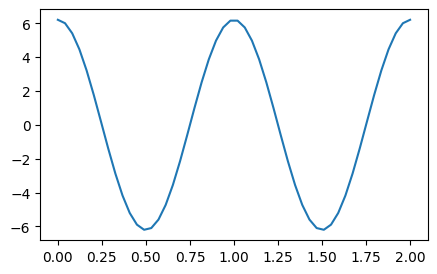[1]:
%matplotlib inline
Matplotlib is building the font cache; this may take a moment.
[2]:
import numpy as np
from sys import path
import matplotlib.pyplot as plt
import matplotlib as mpl
mpl.rcParams['lines.markersize'] = 6
mpl.rcParams['scatter.marker'] = '.'
[3]:
path.append('../../')
import derivative
[4]:
def plot_example(diff_method, t, data_f, res_f, sigmas, y_label=None):
'''
Utility function for concise plotting of examples.
'''
fig, axes = plt.subplots(1, len(sigmas), figsize=[len(sigmas)*4, 3])
# Compute the derivative
res = diff_method.d(np.vstack([data_f(t, s) for s in sigmas]), t)
for i, s in enumerate(sigmas):
axes[i].plot(t, res[i])
axes[i].plot(t, res_f(t))
axes[i].set_title("Noise: $\sigma$={}".format(s))
if y_label:
axes[0].set_ylabel(y_label, fontsize=12)
Usage
There are two ways to interact with the code.
[5]:
t = np.linspace(0, 2, 50)
x = np.sin(2*np.pi*t)
The first way is to do a specific import of the desired Derivative object.
[6]:
from derivative import FiniteDifference
fig,ax = plt.subplots(1, figsize=[5,3])
kind = FiniteDifference(k=1)
ax.plot(t, kind.d(x,t))
[6]:
[<matplotlib.lines.Line2D at 0x7f440afaeb50>]

The second way is top use the functional interface and pass the kind of derivative as an argument.
[7]:
# Use the functional interface and pass the kind as an argument
from derivative import dxdt
fig,ax = plt.subplots(1, figsize=[5,3])
ax.plot(t, dxdt(x, t, "finite_difference", k=1))
[7]:
[<matplotlib.lines.Line2D at 0x7f440aeae0d0>]

Examples
Smooth Derivative
The first example is a sine function with Gaussian noise.
[8]:
def noisy_sin(t, sigma):
'''Sine with gaussian noise.'''
np.random.seed(17)
return np.sin(t) + np.random.normal(loc=0, scale=sigma, size=t.shape)
sigmas = [0, 0.01, 0.1]
fig, ax = plt.subplots(1, len(sigmas), figsize=[len(sigmas)*4, 3])
t = np.linspace(0, 2*np.pi, 50)
for axs, s in zip(ax, sigmas):
axs.scatter(t, noisy_sin(t, s))
axs.set_title("Noise: $\sigma$={}".format(s))

Finite differences
[9]:
fd = derivative.FiniteDifference(3)
plot_example(fd, t, noisy_sin, np.cos, sigmas, 'k: 3')

Savitzky-Golay filter
[10]:
sg = derivative.SavitzkyGolay(left=.5, right=.5, order=2, periodic=False)
plot_example(sg, t, noisy_sin, np.cos, sigmas, 'Periodic: False, window: 1')
sg = derivative.SavitzkyGolay(left=.5, right=.5, order=2, periodic=True)
plot_example(sg, t, noisy_sin, np.cos, sigmas, 'Periodic: True, window: 1')
sg = derivative.SavitzkyGolay(left=2, right=2, order=3, periodic=False)
plot_example(sg, t, noisy_sin, np.cos, sigmas, 'Periodic: False, window: 4')
sg = derivative.SavitzkyGolay(left=2, right=2, order=3, periodic=True)
plot_example(sg, t, noisy_sin, np.cos, sigmas, 'Periodic: True, window: 4')




Splines
[11]:
spl = derivative.Spline(.5)
plot_example(spl, t, noisy_sin, np.cos, sigmas, 's: 0.5, periodic: False')
spl = derivative.Spline(.5, periodic=True)
plot_example(spl, t, noisy_sin, np.cos, sigmas, 's: 0.5, periodic: True')
spl = derivative.Spline(1, periodic=True)
plot_example(spl, t, noisy_sin, np.cos, sigmas, 's: 1, periodic: True')



Spectral method
Add your own filter!
[12]:
no_filter = derivative.Spectral()
yes_filter = derivative.Spectral(filter=np.vectorize(lambda f: 1 if abs(f) < 0.5 else 0))
plot_example(no_filter, t, noisy_sin, np.cos, sigmas, 'No filter')
plot_example(yes_filter, t, noisy_sin, np.cos, sigmas, 'Low-pass filter')


Trend-filtered
[13]:
tvd = derivative.TrendFiltered(alpha=1e-3, order=0, max_iter=1e6)
plot_example(tvd, t, noisy_sin, np.cos, sigmas, 'order: 0')
tvd = derivative.TrendFiltered(alpha=1e-3, order=1, max_iter=1e6)
plot_example(tvd, t, noisy_sin, np.cos, sigmas, 'order: 1')
tvd = derivative.TrendFiltered(alpha=1e-3, order=2, max_iter=1e6)
plot_example(tvd, t, noisy_sin, np.cos, sigmas, 'order: 2')



Kalman smoothing
[14]:
kal = derivative.Kalman(alpha=0.01)
plot_example(kal, t, noisy_sin, np.cos, sigmas, 'alpha: 0.01')
kal = derivative.Kalman(alpha=0.5)
plot_example(kal, t, noisy_sin, np.cos, sigmas, 'alpha: 0.1')
kal = derivative.Kalman(alpha=1)
plot_example(kal, t, noisy_sin, np.cos, sigmas, 'alpha: 1.')



Jump Derivative
The second example is the absolute value function with Gaussian noise.
[15]:
def noisy_abs(t, sigma):
'''Sine with gaussian noise.'''
np.random.seed(17)
return np.abs(t) + np.random.normal(loc=0, scale=sigma, size=x.shape)
d_abs = lambda t: t/abs(t)
sigmas = [0, 0.01, 0.1]
fig, ax = plt.subplots(1, len(sigmas), figsize=[len(sigmas)*4, 3])
t = np.linspace(-1, 1, 50)
for axs, s in zip(ax, sigmas):
axs.scatter(t, noisy_abs(t, s))
axs.set_title("Noise: $\sigma$={}".format(s))

Finite differences
[16]:
fd = derivative.FiniteDifference(k=3)
plot_example(fd, t, noisy_abs, d_abs, sigmas, 'k: 3')

Savitzky-Galoy filter
[17]:
sg = derivative.SavitzkyGolay(left=.125, right=.125, order=2, periodic=True, T=2)
plot_example(sg, t, noisy_abs, d_abs, sigmas, 'window size: .25')
sg = derivative.SavitzkyGolay(left=.25, right=.25, order=3, periodic=True, T=2)
plot_example(sg, t, noisy_abs, d_abs, sigmas, 'window size: .5')


Splines
[18]:
spl = derivative.Spline(.1, periodic=False)
plot_example(spl, t, noisy_abs, d_abs, sigmas, 's: 0.1, periodic: False')

Spectral Method
[19]:
no_filter = derivative.Spectral()
yes_filter = derivative.Spectral(filter=np.vectorize(lambda f: 1 if abs(f) < 1 else 0))
plot_example(no_filter, t, noisy_abs, d_abs, sigmas, 'No filter')
plot_example(yes_filter, t, noisy_abs, d_abs, sigmas, 'Low-pass filter')


Trend-filtered
[20]:
tvd = derivative.TrendFiltered(alpha=1e-3, order=0, max_iter=1e5)
plot_example(tvd, t, noisy_abs, d_abs, sigmas, 'order: 0')

Kalman smoothing
[21]:
kal = derivative.Kalman(alpha=0.01)
plot_example(kal, t, noisy_abs, d_abs, sigmas, 'alpha: 0.01')
kal = derivative.Kalman(alpha=0.1)
plot_example(kal, t, noisy_abs, d_abs, sigmas, 'alpha: 0.1')
kal = derivative.Kalman(alpha=1.)
plot_example(kal, t, noisy_abs, d_abs, sigmas, 'alpha: 1.')



[ ]: